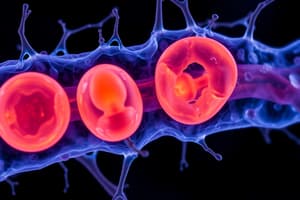Podcast
Questions and Answers
What is the primary function of mitochondria?
What is the primary function of mitochondria?
- Protein synthesis
- Cell signaling
- Energy production (correct)
- Cell division
What is the region inside the inner membrane where the citric acid cycle and fatty acid oxidation take place?
What is the region inside the inner membrane where the citric acid cycle and fatty acid oxidation take place?
- Inner membrane
- Mitochondrial matrix (correct)
- Outer membrane
- Intermembrane space
What is the purpose of the cristae in the inner membrane?
What is the purpose of the cristae in the inner membrane?
- To regulate cellular processes
- To increase the surface area for energy production (correct)
- To decrease the surface area for energy production
- To trigger programmed cell death
What is the function of mtDNA?
What is the function of mtDNA?
What is the role of mitochondria in cell signaling?
What is the role of mitochondria in cell signaling?
What is the outer membrane of mitochondria?
What is the outer membrane of mitochondria?
Flashcards are hidden until you start studying
Study Notes
Mitochondria: Structure and Function
What are Mitochondria?
- Mitochondria (singular: mitochondrion) are organelles found in the cells of most eukaryotes, including animals, plants, and fungi.
- They are often referred to as the "powerhouses" of the cell.
Structure:
- Mitochondria have two main parts: the outer membrane and the inner membrane.
- The outer membrane is permeable, allowing certain substances to pass through.
- The inner membrane is impermeable and folded into a series of cristae, increasing the surface area for energy production.
- The space between the outer and inner membranes is called the intermembrane space.
- The mitochondrial matrix is the region inside the inner membrane where the citric acid cycle and fatty acid oxidation take place.
Functions:
- Energy Production: Mitochondria generate most of the energy for the cell through a process called cellular respiration.
- Cell Signaling: Mitochondria play a role in cell signaling and can trigger programmed cell death (apoptosis) if damaged.
- Regulation of Cellular Processes: Mitochondria help regulate cellular processes, such as cell growth and differentiation.
Mitochondrial DNA:
- Mitochondria have their own DNA, known as mtDNA, which is separate from the DNA found in the cell's nucleus.
- mtDNA is responsible for encoding some of the proteins involved in energy production.
Dysfunction and Disease:
- Mitochondrial dysfunction has been implicated in various diseases, including neurodegenerative disorders, metabolic disorders, and cancer.
- Mitochondrial diseases can result from mutations in mtDNA or nuclear DNA that affect mitochondrial function.
Mitochondria: Structure and Function
What are Mitochondria?
- Mitochondria are organelles found in the cells of most eukaryotes, including animals, plants, and fungi.
- They are often referred to as the "powerhouses" of the cell.
Structure
- Mitochondria have two main parts: the outer membrane and the inner membrane.
- The outer membrane is permeable, allowing certain substances to pass through.
- The inner membrane is impermeable and folded into a series of cristae, increasing the surface area for energy production.
- The space between the outer and inner membranes is called the intermembrane space.
- The mitochondrial matrix is the region inside the inner membrane where the citric acid cycle and fatty acid oxidation take place.
Functions
- Mitochondria generate most of the energy for the cell through cellular respiration.
- Mitochondria play a role in cell signaling and can trigger programmed cell death (apoptosis) if damaged.
- Mitochondria help regulate cellular processes, such as cell growth and differentiation.
Mitochondrial DNA
- Mitochondria have their own DNA, known as mtDNA, which is separate from the DNA found in the cell's nucleus.
- mtDNA is responsible for encoding some of the proteins involved in energy production.
Dysfunction and Disease
- Mitochondrial dysfunction has been implicated in various diseases, including neurodegenerative disorders, metabolic disorders, and cancer.
- Mitochondrial diseases can result from mutations in mtDNA or nuclear DNA that affect mitochondrial function.
Studying That Suits You
Use AI to generate personalized quizzes and flashcards to suit your learning preferences.




